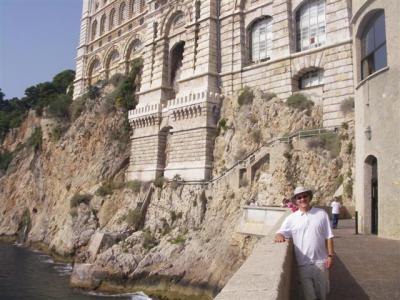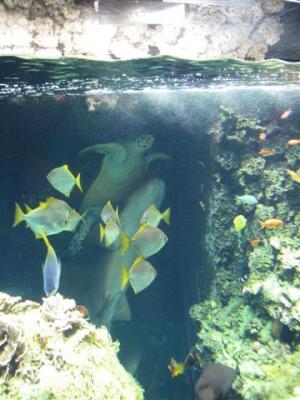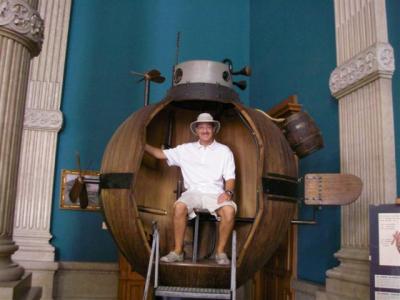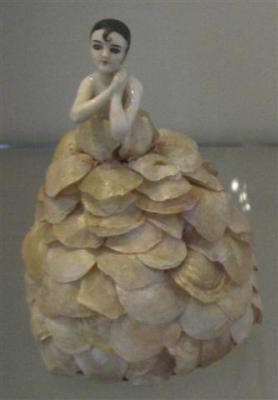It is yet another sunny and beautiful day, but noticeably cooler. We decided that the first thing we wanted to do today was to go to the Oceanographic Museum. Prince Albert 1, the well respected scientist prince, built it in 1910. It was cutting edge at the time. We already mentioned that the building is stunning. It is built into a cliff.

The building has three levels. Like many buildings we have seen in Europe, each floor has high enough ceilings that it could easily be converted into a 6 story or more building. The lowest level is an aquarium, the middle level is for traveling exhibits, and the top is a museum devoted to Ocean related stuff. We headed down to the aquarium.
We have to say that this aquarium is impressive by today’s standards, and almost mind boggling that it was built in 1910. This is the first aquarium to successfully grow coral. They have several different displays. In each one, they have recreated the natural environment by heating the water to the right temperature, setting the light properly, creating the right currents, and making sure the right bacteria and algae are in there along with the flora and fauna. Water is pumped from the sea and filtered so there is a consistent supply of fresh water to the tanks.
All the exhibits are warm water displays. As you walk down the stairs, the first thing you see is the largest tank, which goes all the way to the ceiling (so, at least two stories high since the ceilings are so tall). Higher up in the tank there is a small coral reef with tropical reef fish, and the majority of the tank recreates the open ocean with a lot of pelagic fish. The reef fish all stick in the reef, and the pelagic fish swim all over. There are a lot of really huge specimens in there. The reef fish include puffers, trigger fish, wrasse, clown fish, squirrel fish, butterfly fish”¦ the usual suspects. The pelagic fish include several varieties of sharks, several varieties of rays, jacks and turtles. We think the first photo is a leopard whipray, the second photo is 2 reef sharks and we think a shovelnose ray. The third shot is a shark and turtle swimming together in the reef. You can see the coral and several species of reef fish.



The rest of the displays range in size from what would be considered an enormous tank in a private house to fairly small home tanks. The tanks aren’t nearly as flashy as in Atlanta. There weren’t the big ticket items here like penguins and whales. But, we actually liked this museum better. Except for the giant tank, each display has just a few species in it, and you could get a really good look at everything in the tank.
Most of the tanks have a mix of some sort of coral and some sort of fish species. They really do have a big variety of corals growing, mostly hard. Several tanks had different anemone and clownfish on exhibit. There was a nautilus exhibit that was cool. There was an octopus exhibit that had us entranced as the octopus walked all around the tank with his tentacles in harmony. There are several types of worms, several types of eels, shrimp, and seahorses in various tanks, to give a few specific examples. There were quite a few new fish we have never seen before. We also learned a few names of fish we have seen before but didn’t know the names of.
There was an entire section devoted to species that are hard to see in the wild. We enjoyed this area the most since they are so hard to spot and watch when we go SCUBA diving. For example, we went to a display tank that looked totally empty at first glance, but when we looked more carefully we saw there was a good 20 small stonefish (or scorpionfish) and lobsters in there, hiding amongst the rocks. There was another tank that had some sardines and other fish with a sandy bottom. But, then the sand moved. It turned out there were a half dozen flounder hiding in the sand. The flounder and turbo are fun to watch. They change color to match the sea floor so they always blend into their surroundings. They have a funny shaped head, and actually look like they are misshapen. If you blind them, they can’t change color to match the bottom.
After we finished at the aquarium, we went upstairs to the traveling exhibit. The current display is on the arctic, both the north and south poles. The interior of this level is beautiful, with mosaic floors with ocean theme, marble pillars, and wooden ceilings with paintings between the panels.
In the first room, there was information about the differences between the two poles, the life forms at each of the poles, the great explorers to each of the poles, and the type of research and study they do from the poles. We found the astronomical presentations to be especially interesting. There was an interactive computer presentation on how the tilting of the earth and the earth’s rotation cause the poles to experience the extreme cold and long/short days. There were a few visual aides, such as stuffed penguins and polar bears. Mostly, it was a lot of reading.
The second room focused on environmental concerns. There was detailed information about how the introduction of new species by man (whether intentional or not) has affected the polar ecosystems. There was also information about how extensive hunting, fishing and other activities by man has further upset the natural balance of nature, causing extinction and near extinction of many species. Interestingly, it isn’t only the animals that are hunted and fished by man that are in danger, the animals that feed off the same animals humans hunt are also in danger. Humans are not leaving enough behind for the natural predators to feed on. There was an extensive display on how the overall warming of the planet has caused tremendous ice melts and has further changed the ecosystem. It is hard to deny global warming is real when you see the photos of the crazy ice melts in the last 25 years. This section was more visual than reading. There were many short movies, photos, and vibrant displays. We enjoyed the traveling exhibit and thought it well executed.
We ascended to the top floor, which is similar in décor to the middle level and just as beautiful. We were surprised to see that an “upstairs” had been added. You could go up a flight of stairs to what looks like an exterior metal balcony that runs around the perimeter of the room. There were more displays upstairs, too. There were three separate sections to the display. The first section featured a replica of the Santa Maria, one of the three tiny sailing ships Christopher Columbus’ took across the Atlantic to discover America. Sadly, Christopher Columbus died still thinking he had found India. The first submarine is on display, too (we’re not sure if it is a replica or not). It was invented in 1774 by the same guy who fist used a propeller to make a boat move. The submarine was used against English ships in the American Revolution. They even let you sit inside the submarine, which is pretty cool. The rest of the room features a lot of old paintings with ocean/boat scenes.

The next room is a history of the study of the ocean. There is information on when and how the science started, early tools used, notes and records, and lots of specimens. Both the downstairs and upstairs balcony were packed with specimens. Some were preserved in jars, some stuffed, some bones (especially whales), and a few fossils in stones. There was a recreation of a scientific outing with a model boat and wax dummies in a make shift laboratory within the boat. Seeing all the equipment and instruments used made us appreciate how far science has come, and how easy we have it today in the boating world. Seeing the complex detailing of the specimens and so darn many specimens made us appreciate what a vast and complex science oceanography is.
The last room was more eclectic. On the main floor, there were a few more specimens, including some sea birds. There was some more oceanography history. Of particular interest was a display on the history of diving and the evolution of air supply and suits. We hadn’t realized that the first successful attempts at supplying air to divers dates back to 1797. There was a shell display, some boats, and a few more odds and ends.
The entire upstairs balcony area was devoted exclusively to art with ocean themes. Some of the art was quite old, so old that they could be considered ancient artifacts. Some of it was more modern. We are guessing the majority of it was from the colonial era. It came from all over the world, including places like the South Pacific, Asia, Africa, Alaska and other exotic places, as well as less exotic places around Europe. Most of the art was actually made out of sea creatures, such as bones, shells, teeth, and other body parts. And some of it was simply portrayals of sea scenes out of more conventional materials such as ceramic and glass. The art includes decorative hanging pieces, jewelry, dolls, pipes, utensils, earthenware, statuettes, fishing accoutrements, and more.


After we finished at the museum, we went to a near by chocolate shop where they offer chocolate tastings. It is really high quality chocolate, but we were surprised by the lack of variety to the chocolates chosen for the tasting. They were all so similar. Not that we would ever complain about chocolate!
Then we went to the History of Monaco movie. It is a 35 minute run down from 1297, when the Grimaldi’s seized the fortress, until now. It was a good, but quick, overview, and was, of course, very slanted to make the Grimaldis look quite favorable. In the Malta Experience, they had actors recreating scenes in history used in conjunction with drawings and photos. This one was all drawings and photos, with no re-enactments.
A disproportionate amount of time was spent focused on Princess Grace, which is no surprise since Princess Grace seems to be a huge icon here. All the histories we pulled up and all the information we found in doing research all focused on Grace and glossed over the rest of the last 700 years. Many buildings have a sign saying on this date Princess Grace did this here. No other prince or princess has signs noting what they did, including Rainier or Albert. In everything we read or hear, Grace was adored by the people and is portrayed as perfect in every way.
